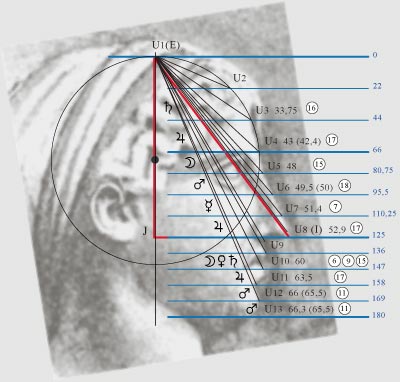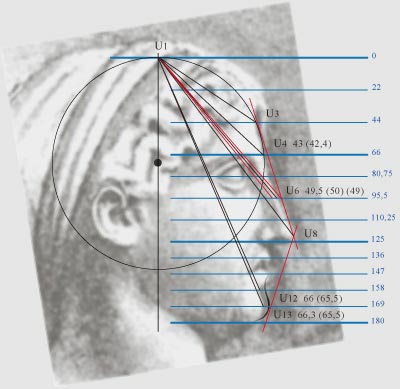-
Similarity of human face features with geometrical shapes of correct
equipotent polygons allows to speak not only about harmonious or disharmonious
facial proportions, but also about properties of human character traits as polygons
correspond with astrological planets, and therefore according to meanings of
planets in astrology it is possible to describe human psychological
characteristics. Namely if facial features are similar to shapes of those or
other polygons, and in particular if levels of a face according to the
physiognomic scale of measurements coincide with angular sizes and lines of
polygons then it is possible to connect psychological values of these levels
with astrological meanings of corresponding planets.
The important value belongs to lines which connect point U1 to other key points
of a human face, that is shown on the chart.
 |
The chart for an example shows the facial profile
of Greek goddess Artemis which was represented on walls of Parthenon. Shown profile of Artemis is focused concerning the physiognomic scale of measurements: - sphere of consciousness has size 0-66 zens; - sphere of individuality has size 66-125 zens; - sphere of feelings has size 125-180 zens. The line of a head top is latent by hair and consequently is shown approximately. Point U1 corresponds with the line of a head top and in essence is point E in triangle JEI, and therefore this key dot is important at comparison of facial features with shapes of geometrical figures, namely angular sizes of lines from U1-U2 to U1-U13 specify important parameters of human characters. |
The angular size of line U1-U2
cannot be measured concretely, but it is possible to assume that point U2
is in crossing of the line of a forehead top with circle of consciousness, and
then the angular slant of U1-U2 has size 24 degrees that coincides with shapes
of a geometrical figure of 15 angles or tripentagon.
The angular size of U1-U3 is 33,75 degrees that coincides with geometrical shapes of a dioctagon.
The angular size of U1-U4 is 43 degrees that is approximately equal 42,4 degrees and coincides with
geometrical shapes of a polygon with 17 angles.
The angular size of U1-U5 is 48 degrees that coincides with geometrical shapes of a tripentagon.
The angular size of U1-U6 is 49,5 degrees that is approximately equal to 50
degrees and coincides with shapes of a dinonagon.
The angular size of U1-U7 is 51,4 degrees that coincides with geometrical shapes of a heptagon.
The angular size of U1-U8 is 52,9 degrees that coincides with shapes of a
geometrical figure of 17 angles.
If to draw triangle JEI (shown by red color) then the angle
in point I has size 52,9 degrees that approximately corresponds to parameters of
the sacred Egyptian triangle and is a remarkable feature of the shown facial profile of
Artemis.
The angular size of line U1-U9
cannot be measured concretely as the shown sculptural image of Artemis does not allow to
see position of point U9.
The angular size of U1-U10 is 60 degrees that coincides with geometrical shapes of a hexagon, a
nonagon, a tripentagon.
The angular size of U1-U11 is 63,5 degrees that coincides with shapes of a
geometrical polygon with 17 angles.
The angular sizes of lines U1-U12 and U1-U13 are 66 and 66,3 degrees, that is approximately equal
for 65,5 degrees and coincides
with geometrical shapes of a geometrical figure with 11 angles.
To the listed polygons there correspond astrological planets.
The information on parities of planets in astrology with formal shapes of
geometrical figures look on 7 page in this section of website.
To the forehead middle there corresponds the planet Saturn.
To eyebrows and nose-tip and lower lip there corresponds the planet Jupiter.
To the nose bridge middle and to the chin and to the interval between chin and
lower lip there corresponds the planet Mars.
To the nose bridge top there corresponds the Moon, and also it is possible to assume
that to the forehead top too there corresponds the Moon.
To the nose bridge bottom there corresponds the planet Mercury.
To the upper lip there correspond planets Venus and Saturn and Moon.
The chart shows traditional symbols of planets in astrology, and polygons are
designated by numbers in circles.
Eyebrows and nose tip and lower lip are the most appreciable facial features
which correspond with the planet Jupiter, that allows to speak about imperious
properties of character traits as Jupiter in astrology symbolizes authority.
The nose bridge middle and chin and interval between chin and lower lip
correspond with the planet Mars, that allows to speak about resolute and
courageous properties of character traits as such psychological characteristics
correspond to Mars in astrology.
And also parities of facial features with other planets allow to speak about
psychological properties of character.
It is necessary to pay attention that angular sizes of lines U1-U4, U1-U6,
U1-U12, U1-U13 coincide with geometrical shapes of polygons not absolutely
precisely, and consequently corresponding features of a face seem unsatisfactory
or ugly. Namely it is possible to tell that eyebrows, the nose bridge middle,
the chin, the interval between chin and lower lip in the shown facial profile
Artemis are wrong. Possibly, ancient Greek sculptor has discrepancies and as a
result in the Artemis's sculptural half face it is possible to see deviations
from a correct canon of beauty which is caused by similarity to correct
geometrical figures.
Namely it is necessary to increase outlines
of eyebrows that the angular size of line U1-U4
was equal to 42,4 degrees (43-0,6=42,4), that precisely corresponds to
geometrical shapes of a correct polygon with 17 angles.
It is necessary to reduce outlines of the nose bridge middle that the angular
size of line U1-U6
was equal to 50 degrees (49,5+0,5=50), or it is possible to increase the outlines of
the nose bridge middle that the angular size of U1-U6
was equal to 49 degrees (49,5-0,5=49), that corresponds to geometrical shapes of a
polygon with 11 angles.
It is necessary to increase outlines of the
interval between chin and lower lip that the angular size of the line U1-U12
was equal to 65,5 degrees (66-0,5=65,5).
It is necessary to increase outlines of the chin that the angular size of U1-U13
was equal to 65,5 degrees (66,3-0,8=65,5).
Similarities to shapes of correct equipotent polygons will be exact
and facial features in the Artemis's sculptural half face will have correct outlines
as a result of such corrections, that is shown on the chart:
 |
Dark color shows lines which correspond with real
features in the face of Artemis, and red color shows lines which correspond to
geometrical shapes of correct polygons. If outlines of the nose bridge middle are increased in comparison with real facial features then the angular size of U1-U6 is 49 degrees, that corresponds to proportions of a geometrical figure with 11 angles. And if outlines of the nose bridge middle are reduced in comparison with real facial features of Artemis then the angular slant of the line U1U6 has size of 50 degrees, that corresponds to proportions of a dinonagon. If outlines of eyebrows are increased in comparison with real features of Artemis's face, and if point U4 coincides with the line U3-U8 then the angular size of the line U1-U4 is 42,4 degrees, that corresponds to proportions of a geometrical polygon with 17 angles. If angular slants of lines U1-U12 and U1-U13 have sizes of 65,5 degrees, namely if outlines of the chin and also outlines of the interval between chin and lower lip approximately correspond with the drawn dark contour then lines U1-U12 and U1-U13 coincide with proportions of a geometrical figure with 11 angles. |
-
If the listed corrections are observed then lines U4-U8 and U8-U13 (shown by red color)
have sizes of angular slants 72 degrees. Namely the line U4-U8 which is tangent
to the nose-tip and eyebrows expressed points, and also the line U8-U13 which is
tangent to the nose-tip and the chin expressed points as a result of corrections
have angular sizes of 72 degrees, that corresponds to proportions of a pentagon
which is a parameter of proportional canon of a human face in ancient Greek
sculptures.
In a similar way by means of geometrical research of human faces in a context of
physiognomy, or in cosmetic medicine and plastic surgery it is possible to see
harmonious and disharmonious proportional ratios in facial profiles of people
according to proportions of geometrical figures. And also it is possible to find
explanations to visual impressions according to which own face or faces of other
people seems beautiful or ugly. As people see beautiful in correct forms and
find ugly in wrong forms. But if the man or woman realizes laws of geometry and
principles of geometrical proportions then can see that the reason of
unsatisfactory impressions are inexact concurrences to shapes of correct
polygons, or the reason of unsatisfactory impressions are not coordinated ratios
of geometrical shapes.
For example, if contours of a chin have inexact concurrence to shapes of any
polygon then the man or woman feels such discrepancy. Or if contours of a chin
and a nose are similar to shapes of different polygons which are not coordinated
then there is a discontent with own facial appearance. Or if the man or woman
perceives as beautiful faces which are similar to shapes of other polygons,
rather than polygons to which features of own face are similar then there is a
discontent with own facial appearance.
There are different reasons of discontent which can be caused by psychological
features of a person or by influences of stereotypes, that is necessary to
consider in physiognomy, and also in services of cosmetic medicine and clinics
of plastic surgery.
I hope that the information in this section of website can be necessary in clinics cosmetic medicine and plastic surgery, as surgical correction of facial appearance, or psychological correction of human appearance without plastic operations and radical cosmetic procedures, can be performed with application of offered methods of physiognomic measurements and geometrical researches of a human face.
In following section with the name half-faces (concepts 4) on pages of this website also look the information on physiognomy of a human face, and in particular look parities of twelve physiognomic levels with astrological circle and signs on the zodiac in astrology.
-